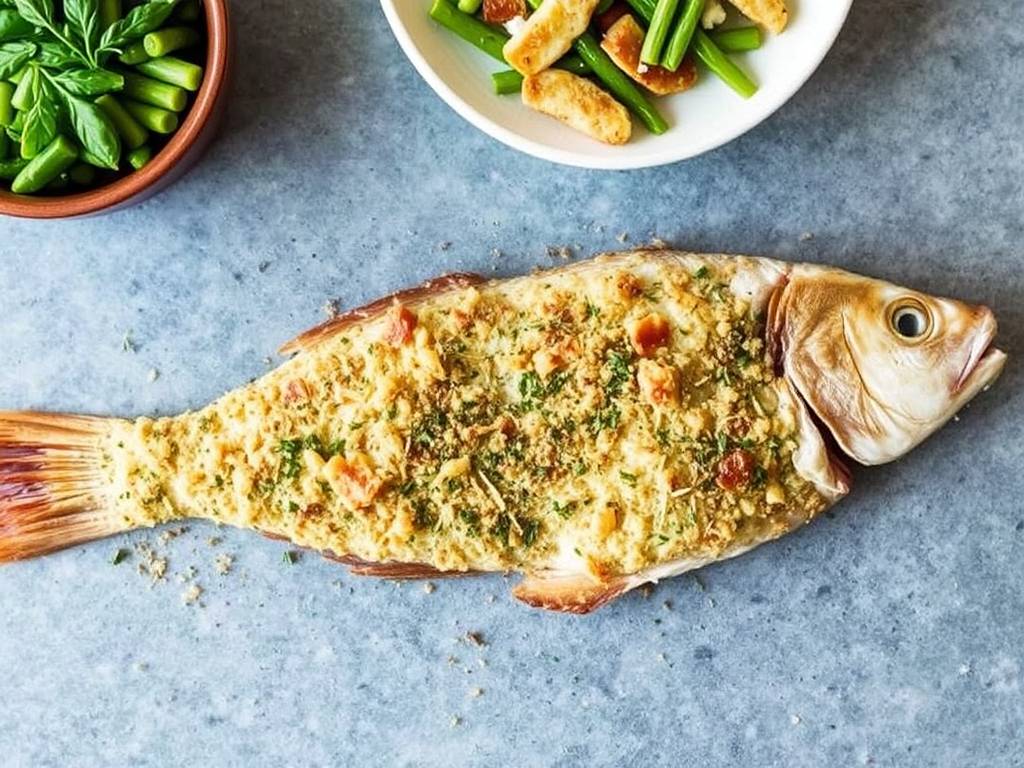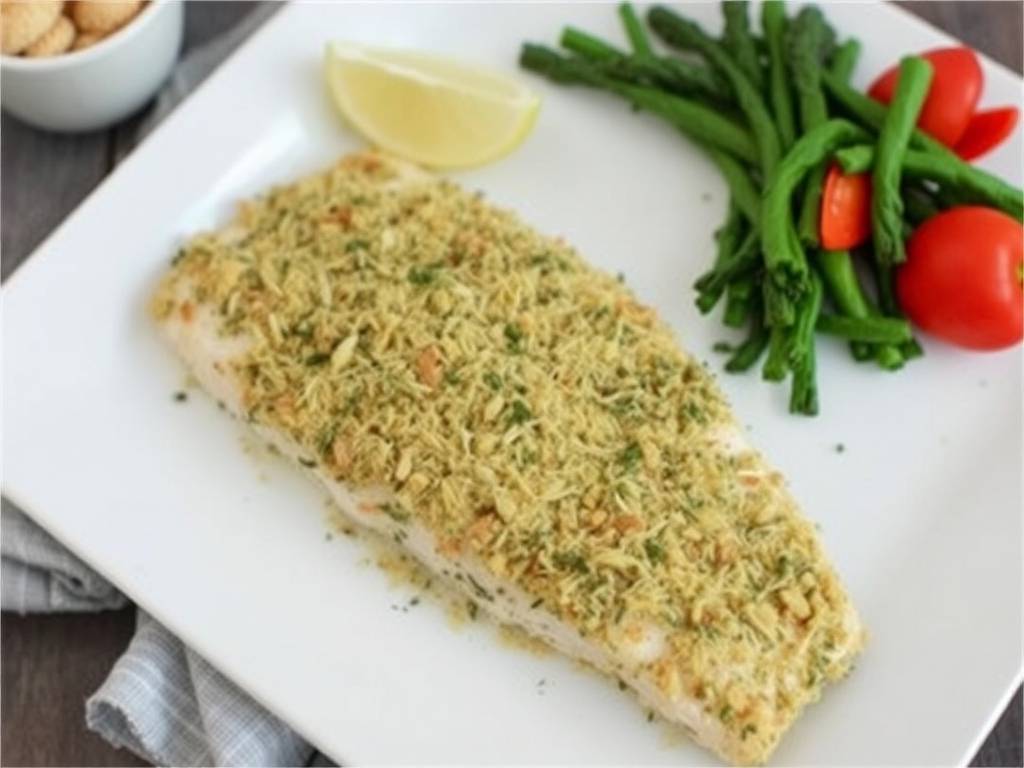The Art of Baking Fish with a Crispy Herb and Parmesan Crust
The gentle art of baking fish is one of the most reliable and healthful techniques in a home cook’s repertoire. It’s a method that respects the delicate nature of seafood, coaxing out its natural flavours without overwhelming them. Yet, sometimes, a simple piece of baked fish yearns for a little drama, a textural contrast to its tender flakiness. This is where the magnificent Herb and Parmesan Crust enters the stage. More than just a topping, this crust is a golden, fragrant armour that seals in moisture, delivers a powerful punch of savoury, umami-rich flavour, and provides an irresistible crispy crunch with every bite. Mastering this dish is not about complex techniques, but about understanding the harmony of a few quality ingredients.
The journey to perfection begins not with the crust, but with the foundation: the fish itself. The beauty of this recipe is its versatility. Firm, mild white fish fillets are the ideal candidates, as they provide a sturdy canvas that won’t disintegrate under the weight of the crust. Excellent choices include cod, haddock, halibut, or sea bass. Thicker cuts, about one to one and a half inches thick, work best as they are less likely to overcook before the crust has achieved its glorious golden brown hue. Salmon, with its richer flavour and higher fat content, is also a fantastic option, creating a beautiful contrast with the salty, herbal crust.

Once you have selected your fish, preparation is key. Pat the fillets completely dry with paper towels. This step is non-negotiable. Any residual moisture on the surface will steam the fish rather than allow it to sear and will prevent the crust from adhering properly, leading to a sad, soggy topping. Next, season both sides generously with kosher salt and freshly ground black pepper. This foundational seasoning is crucial for ensuring the fish itself is flavourful, not just its coating. Let the seasoned fillets sit at room temperature for about 15-20 minutes. This simple act takes the chill off the fish, promoting more even cooking throughout.
Now, we turn our attention to the star of the show: the crust. This is where personal expression begins. The core components are simple: breadcrumbs, Parmesan cheese, fresh herbs, and a binding agent.
The choice of breadcrumbs significantly influences the final texture. Fresh breadcrumbs, made by pulsing day-old rustic bread like a baguette or ciabatta in a food processor, yield a lighter, more delicate crunch. Dried, store-bought breadcrumbs offer a denser, more uniform texture. For a deeper flavour, consider using Panko, the Japanese-style breadcrumbs known for their airy, flaky quality that results in an exceptionally crispy and light crust. A combination of Panko and freshly grated Parmesan cheese creates a perfect balance of crispness and flavour.
Speaking of Parmesan, quality is paramount. Avoid the pre-grated cheese found in tubs, which often contains anti-caking agents like cellulose that can prevent it from melting and browning properly. Instead, buy a wedge of authentic Parmigiano-Reggiano or a good-quality Grana Padano and grate it yourself just before using. The difference in flavour and melting capability is profound. The Parmesan brings a deep, nutty, salty umami that forms the savoury backbone of the crust.
The herbal component is where the crust truly comes to life. While dried herbs can be used in a pinch, fresh herbs impart a vibrant, aromatic quality that is simply unmatched. A classic combination includes flat-leaf parsley, with its fresh, clean taste; chives, offering a subtle onion note; and dill, which has a particular affinity for fish. Thyme and oregano are also wonderful additions, but use them sparingly as they are more potent. Finely chop the herbs to ensure they distribute evenly throughout the crust mixture. The goal is a confetti of green flecks speckled through the golden breadcrumbs.
To bind these dry ingredients together and encourage browning, we need fat and moisture. Unsalted butter, melted, is a traditional and delicious choice, lending a rich flavour and promoting a beautiful, even browning. For a lighter alternative, a good quality extra-virgin olive oil works wonderfully, contributing its own fruity, peppery notes. A third, excellent option is mayonnaise. While it may sound unconventional, mayonnaise—being an emulsion of oil and egg—creates an incredibly moist, rich, and uniformly golden crust that adheres perfectly. A touch of Dijon mustard or the zest of a lemon can be added to the binding agent for an extra layer of complexity and brightness.
To assemble the crust, combine the breadcrumbs, grated Parmesan, and chopped herbs in a bowl. Season this mixture lightly with a pinch of salt (remembering the Parmesan is already salty) and black pepper. Drizzle in your chosen melted butter, oil, or mayonnaise, and mix until the dry ingredients are evenly moistened. The mixture should hold together loosely when pinched. It should not be soggy or feel like a paste.
With your fish prepared and your crust mixture ready, it’s time for assembly. Place the seasoned fish fillets on a baking sheet. For easy cleanup and to prevent sticking, line the sheet with parchment paper. A light mist of cooking spray on the paper provides an extra guarantee. Using a spoon or your fingers, gently pat a thick, even layer of the crust mixture onto the top of each fillet. Press down lightly to ensure good adhesion, covering the entire surface. There is no need to crust the bottom of the fillet.
The baking process is the final, critical act. Preheat your oven to a high temperature, around 400°F (200°C). A hot oven is essential for two reasons: it quickly cooks the fish, preserving its moisture, and it rapidly browns and crisps the crust. The exact baking time will depend entirely on the thickness of your fillets. A good rule of thumb is to bake for about 10-15 minutes per inch of thickness. The fish is done when it flakes easily with a fork at its thickest part and the crust is a deep, golden brown. An instant-read thermometer inserted into the center of the fish should read 145°F (63°C). Avoid opening the oven door frequently, as this causes temperature fluctuations that can hinder the crisping process.
For an extra-perfect finish, consider using the broiler for the last minute or two of cooking. Keep a watchful eye during this time, as the crust can go from golden to burnt in seconds. This final blast of direct heat ensures maximum crispiness and a beautiful colour.

Once out of the oven, allow the fish to rest on the baking sheet for 2-3 minutes. This allows the juices to redistribute throughout the fillet, ensuring every bite is succulent. A final squeeze of fresh lemon juice over the top just before serving cuts through the richness of the crust and brightens all the flavours.
Serving suggestions for this magnificent dish are plentiful. For a light and healthy meal, serve it alongside a simple arugula salad dressed with lemon vinaigrette, or over a bed of sautéed spinach that wilts gently under the warm fish. It pairs beautifully with roasted vegetables like asparagus, cherry tomatoes, or zucchini, which can be cooked on the same baking sheet. For a more substantial plate, creamy mashed potatoes, buttery orzo, or fluffy quinoa make excellent bases to soak up any delicious juices.
In conclusion, baking fish with a Herb and Parmesan Crust is a culinary technique that elevates a simple ingredient into a restaurant-quality dish with minimal effort. It is a testament to the power of contrasting textures and complementary flavours. By starting with a quality piece of fish, creating a balanced and aromatic crust, and employing a high-heat baking method, you can consistently produce a meal that is both impressively elegant and deeply satisfying. It is a recipe that invites experimentation and reliably delivers a result that will delight any palate.






发表评论